Engage NY Eureka Math 7th Grade Module 3 Lesson 23 Answer Key
Eureka Math Grade 7 Module 3 Lesson 23 Exploratory Challenge Answer Key
Exploratory Challenge: The Volume of a Right Prism
What is the volume of the right prism pictured on the right? Explain.
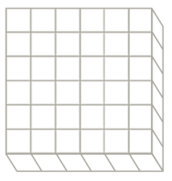
Answer:
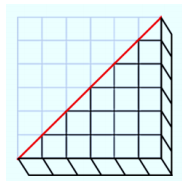
The volume of the right prism is 36 units3 because the prism is filled with 36 cubes that are 1 unit long, 1 unit wide, and 1 unit high, or 1 unit3.
Draw the same diagonal on the square base as done above; then, darken the grid lines on the lower right triangular prism. What is the volume of that right triangular prism? Explain.
Answer:
The volume of the right triangular prism is 18 units3. There are 15 cubes from the original right prism and 6 right triangular prisms that are each half of a cube. The 6 right triangular prisms can be paired together to form 3 cubes, or 3 units3. Altogether the area of the right triangular prism is (15+3) units3, or 18 units3.
How could we create a right triangular prism with five times the volume of the right triangular prism pictured to the right, without changing the base? Draw your solution on the diagram, give the volume of the solid, and explain why your solution has five times the volume of the triangular prism.
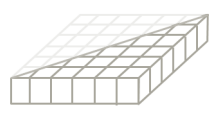
Answer:
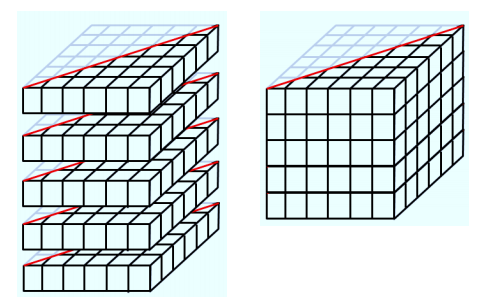
If we stack five exact copies of the base (or bottom floor), the prism then has five times the number of unit cubes as the original, which means it has five times the volume, or 90 units3.
What could we do to cut the volume of the right triangular prism pictured on the right in half without changing the base? Draw your solution on the diagram, give the volume of the solid, and explain why your solution has half the volume of the given triangular prism.
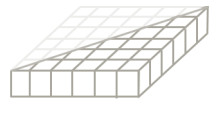
Answer:
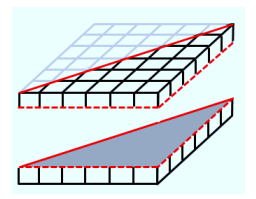
If we slice the height of the prism in half, each of the unit cubes that make up the triangular prism will have half the volume as in the original right triangular prism. The volume of the new right triangular prism is 9 units3.
To find the volume (V) of any right prism …
Answer:
Multiply the area of the right prism’s base (B) times the height of the right prism (h), V = Bh.
Eureka Math Grade 7 Module 3 Lesson 23 Example Answer Key
Example: The Volume of a Right Triangular Prism
Find the volume of the right triangular prism shown in the diagram using V = Bh.
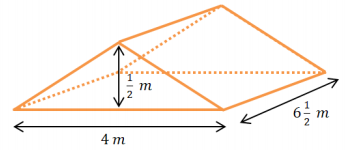
Answer:
V = Bh
V = (\(\frac{1}{2}\) lw)h
V = (\(\frac{1}{2}\) ∙ 4 m ∙ \(\frac{1}{2}\) m) ∙ 6 \(\frac{1}{2}\) m
V = (2 m ∙ \(\frac{1}{2}\) m) ∙ 6 \(\frac{1}{2}\) m
V = 1 m2 ∙ 6 \(\frac{1}{2}\) m
V = 6 \(\frac{1}{2}\) m3 The volume of the triangular prism is 6 \(\frac{1}{2}\) m3.
Eureka Math Grade 7 Module 3 Lesson 23 Exercise Answer Key
Opening Exercise
The volume of a solid is a quantity given by the number of unit cubes needed to fill the solid. Most solids—rocks, baseballs, people—cannot be filled with unit cubes or assembled from cubes. Yet such solids still have volume. Fortunately, we do not need to assemble solids from unit cubes in order to calculate their volume. One of the first interesting examples of a solid that cannot be assembled from cubes, but whose volume can still be calculated from a formula, is a right triangular prism.
What is the area of the square pictured on the right? Explain.
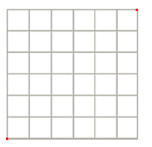
Answer:
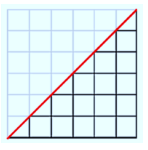
The area of the square is 36 units2 because the region is filled with 36 square regions that are 1 unit by 1 unit, or 1 unit2.
Draw the diagonal joining the two given points; then, darken the grid lines within the lower triangular region. What is the area of that triangular region? Explain.
Answer:
The area of the triangular region is 18 units2. There are 15 unit squares from the original square and 6 triangular regions that are \(\frac{1}{2}\) unit2. The 6 triangles can be paired together to form 3 units2. Altogether the area of the triangular region is (15+3) units2, or 18 units2.
Exercise: Multiple Volume Representations
The right pentagonal prism is composed of a right rectangular prism joined with a right triangular prism. Find the volume of the right pentagonal prism shown in the diagram using two different strategies.

Answer:
Strategy #1
The volume of the pentagonal prism is equal to the sum of the volumes of the rectangular and triangular prisms.
V = Vrectangular prism + Vtriangular prism
V = Bh
V = (lw)h
V = (4 m ∙ 6 \(\frac{1}{2}\) m) ∙ 6 \(\frac{1}{2}\) m
V = (24 m2+2 m2) ∙ 6 \(\frac{1}{2}\) m
V = 26 m2 ∙ 6 \(\frac{1}{2}\) m
V = 156 m3+13 m3
V = 169 m3
V = Bh
V = (\(\frac{1}{2}\) lw)h
V = (\(\frac{1}{2}\) ∙ 4 m ∙ \(\frac{1}{2}\) m) ∙ 6 \(\frac{1}{2}\) m
V = (2 m ∙ \(\frac{1}{2}\) m) ∙ 6 \(\frac{1}{2}\) m
V = (1 m2 ) ∙ 6 \(\frac{1}{2}\) m
V = 6 \(\frac{1}{2}\) m3
So the total volume of the pentagonal prism is 169 m3+6 \(\frac{1}{2}\) m3, or 175 \(\frac{1}{2}\) m3 .
Strategy #2
The volume of a right prism is equal to the area of its base times its height. The base is a rectangle and a triangle.
V = Bh
B = Arectangle + Atriangle
Arectangle = 4 m ∙ 6 \(\frac{1}{2}\) m
Arectangle = 24 m2+2 m2
Arectangle = 26 m2
Atriangle = \(\frac{1}{2}\) ∙ 4 m ∙ \(\frac{1}{2}\) m
Atriangle = 2 m ∙ \(\frac{1}{2}\) m
Atriangle = 1 m2
V = Bh
V = 27 m2 ∙ 6 \(\frac{1}{2}\) m
V = 162 m3+13 \(\frac{1}{2}\) m3
V = 175 \(\frac{1}{2}\) m3
B = 26 m2+1 m2
B = 27 m2
The volume of the right pentagonal prism is 175 \(\frac{1}{2}\) m3.
Eureka Math Grade 7 Module 3 Lesson 23 Problem Set Answer Key
Question 1.
Calculate the volume of each solid using the formula V = Bh (all angles are 90 degrees).
a.
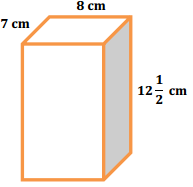
Answer:
V = Bh
V = (8 cm ∙ 7 cm) ∙ 12 \(\frac{1}{2}\) cm
V = (56 ∙ 12 \(\frac{1}{2}\)) cm3
V = 672 cm3+28 cm3
V = 700 cm3
The volume of the solid is 700 cm3.
b.
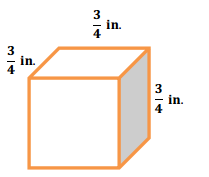
Answer:
V = Bh
V = (\(\frac{3}{4}\) in. ∙ \(\frac{3}{4}\) in.) ∙ \(\frac{3}{4}\) in.
V = (9/16) ∙ \(\frac{3}{4}\) in3
V = \(\frac{27}{64}\) in3
The volume of the cube is \(\frac{27}{64}\) in3.
c.
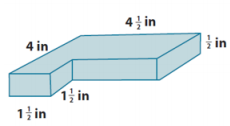
Answer:
V = Bh
B = Arectangle+Asquare
B = lw+s2
B = (2 \(\frac{1}{2}\) in. ∙ 4 \(\frac{1}{2}\) in.)+(1 \(\frac{1}{2}\) in.)2
B = (10 in2+1 \(\frac{1}{4}\) in2 )+(1 \(\frac{1}{2}\) in. ∙ 1 \(\frac{1}{2}\) in.)
B = 11 \(\frac{1}{4}\) in2+(1 \(\frac{1}{2}\) in2+\(\frac{3}{4}\) in2 )
B = 11 \(\frac{1}{4}\) in2+\(\frac{3}{4}\) in2+1 \(\frac{1}{2}\) in2
B = 12 in2+1 \(\frac{1}{2}\) in2
B = 13 \(\frac{1}{2}\) in2
V = Bh
V = 13 \(\frac{1}{2}\) in2 ∙ \(\frac{1}{2}\) in.
V = \(\frac{13}{2}\) in3+\(\frac{1}{4}\) in3
V = 6 in3+\(\frac{1}{2}\) in3+\(\frac{1}{4}\) in3
V = 6 \(\frac{3}{4}\) in3
The volume of the solid is 6 \(\frac{3}{4}\) in3.
d.

Answer:
V = Bh
B = (A(lg rectangle)-(Asm rectangle)
B = (lw)1– (lw)2
B = (6 yd. ∙ 4 yd.)-(1 \(\frac{1}{3}\) yd. ∙ 2 yd.)
B = 24 yd2-(2 yd2+\(\frac{2}{3}\) yd2 )
B = 24 yd2-2 yd2–\(\frac{2}{3}\) yd2
B = 22 yd2–\(\frac{2}{3}\) yd2
B = 21 \(\frac{1}{3}\) yd2
V = Bh
V = (21 \(\frac{1}{3}\) yd2) ∙ \(\frac{2}{3}\) yd.
V = 14 yd3+(\(\frac{1}{3}\) yd2 ∙ \(\frac{2}{3}\) yd.)
V = 14 yd3+\(\frac{2}{9}\) yd3
V = 14 \(\frac{2}{9}\) yd3
The volume of the solid is 14 \(\frac{2}{9}\) yd3.
e.
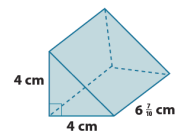
Answer:
V = Bhprism
B = \(\frac{1}{2}\) bhtriangle
B = \(\frac{1}{2}\) ∙ 4 cm ∙ 4 cm
B = 2 ∙ 4 cm2
B = 8 cm2
V = Bh
V = 8 cm2 ∙ 6 \(\frac{7}{10}\) cm
V = 48 cm3+\(\frac{56}{10}\) cm3
V = 48 cm3+5 cm3+6/10 cm3
V = 53 cm3+\(\frac{3}{5}\) cm3
V = 53 \(\frac{3}{5}\) cm3
The volume of the solid is 53 \(\frac{3}{5}\) cm3.
f.
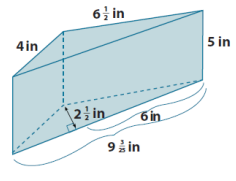
Answer:
V = Bhprism
B = \(\frac{1}{2}\) bhtriangle
B = \(\frac{1}{2}\) ∙ 9 \(\frac{3}{25}\) in. ∙ 2 \(\frac{1}{2}\) in.
B = \(\frac{1}{2}\) ∙ 2 \(\frac{1}{2}\) in. ∙ 9 3/25 in.
B = (1 \(\frac{1}{4}\) ) ∙ (9 \(\frac{3}{25}\) )in2
B = (\(\frac{5}{4}\) ∙ \(\frac{228}{25}\) )in2
B = \(\frac{57}{5}\) in2
V = Bh
V = (\(\frac{57}{5}\) in2 ) ∙ 5 in
V = 57 in3
The volume of the solid is 57 in3.
g.
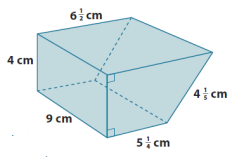
Answer:
V = Bh
B = Arectangle + Atriangle
B = lw+\(\frac{1}{2}\) bh
B = (5 \(\frac{1}{4}\) cm ∙ 4 cm)+\(\frac{1}{2}\) (4 cm ∙ 1 \(\frac{1}{4}\) cm)
B = (20 cm2+1 cm2 )+(2 cm ∙ 1 \(\frac{1}{4}\) cm)
B = 21 cm2+2 cm2+\(\frac{1}{2}\) cm2
B = 23 cm2+\(\frac{1}{2}\) cm2
B = 23 \(\frac{1}{2}\) cm2
V = Bh
V = 23 \(\frac{1}{2}\) cm2 ∙ 9 cm
V = 207 cm3+\(\frac{9}{2}\) cm3
V = 207 cm3+4 cm3+\(\frac{1}{2}\) cm3
V = 211 \(\frac{1}{2}\) cm3
The volume of the solid is 211 \(\frac{1}{2}\) cm3.
h.
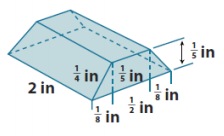
Answer:
V = Bh
V = \(\frac{1}{8}\) in2 ∙ 2 in.
V = \(\frac{1}{4}\) in3
B = Arectangle+2Atriangle
B = lw+2 ∙ \(\frac{1}{2}\) bh
B = (\(\frac{1}{2}\) in. ∙ \(\frac{1}{5}\) in.)+(1 ∙ \(\frac{1}{8}\) in. ∙ \(\frac{1}{5}\) in.)
B = \(\frac{1}{10}\) in2+\(\frac{1}{40}\) in2
B = \(\frac{4}{40}\) in2+\(\frac{1}{40}\) in2
The volume of the solid is \(\frac{1}{4}\) in3.
B = \(\frac{5}{40}\) in2
B = \(\frac{1}{8}\) in2
Question 2.
Let l represent the length, w the width, and h the height of a right rectangular prism. Find the volume of the prism when
a. l = 3 cm, w = 2 \(\frac{1}{2}\) cm, and h = 7 cm.
Answer:
V = lwh
V = 3 cm ∙ 2 \(\frac{1}{2}\) cm ∙ 7 cm
V = 21 ∙ (2 \(\frac{1}{2}\) ) cm3
V = 52 \(\frac{1}{2}\) cm3 The volume of the prism is 52 \(\frac{1}{2}\) cm3.
l = \(\frac{1}{4}\) cm, w = 4 cm, and h = 1 \(\frac{1}{2}\) cm.
V = lwh
V = \(\frac{1}{4}\) cm ∙ 4 cm ∙ 1 \(\frac{1}{2}\) cm
V = 1 \(\frac{1}{2}\) cm3 The volume of the prism is 1 \(\frac{1}{2}\) cm3.
Question 3.
Find the length of the edge indicated in each diagram.
a. V = Bh
Let h represent the number of inches in the height of the prism.
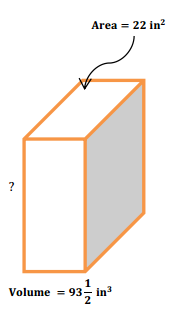
93 \(\frac{1}{2}\) in3 = 22 in2 ∙ h
93 \(\frac{1}{2}\) in3 = 22h in2
22h = 93.5 in
h = 4.25 in
The height of the right rectangular prism is 4 \(\frac{1}{4}\) in.
What are possible dimensions of the base?
11 in by 2 in, or 22 in by 1 in
b. V = Bh
Let h represent the number of meters in the height of the triangular base of the prism.
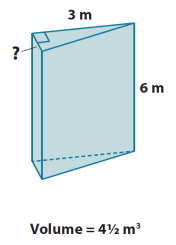
V = (\(\frac{1}{2}\) bhtriangle) ∙ hprism
4 \(\frac{1}{2}\) m3 = (\(\frac{1}{2}\) ∙ 3 m ∙ h) ∙ 6 m
4 \(\frac{1}{2}\) m3 = \(\frac{1}{2}\) ∙ 18 m2 ∙ h
4 \(\frac{1}{2}\) m3 = 9h m2
9h = 4.5 m
h = 0.5 m
The height of the triangle is \(\frac{1}{2}\) m.
Question 4.
The volume of a cube is 3 \(\frac{3}{8}\) in3. Find the length of each edge of the cube.
Answer:
V = s3, and since the volume is a fraction, the edge length must also be fractional.
3 \(\frac{3}{8}\) in3 = \(\frac{27}{8}\) in3
3 \(\frac{3}{8}\) in3 = \(\frac{3}{2}\) in. ∙ \(\frac{3}{2}\) in. ∙ \(\frac{3}{2}\) in.
3 \(\frac{3}{8}\) in3 = (\(\frac{3}{2}\) in.)3
The lengths of the edges of the cube are \(\frac{3}{2}\) in., or 1 \(\frac{1}{2}\) in.
Question 5.
Given a right rectangular prism with a volume of 7 \(\frac{1}{2}\) ft3, a length of 5 ft., and a width of 2 ft., find the height of the prism.
Answer:
V = Bh
V = (lw)h Let h represent the number of feet in the height of the prism.
7 \(\frac{1}{2}\) ft3 = (5ft. ∙ 2ft.) ∙ h
7 \(\frac{1}{2}\) ft3 = 10 ft2 ∙ h
7.5 ft3 = 10h ft2
h = 0.75 ft.
The height of the right rectangular prism is \(\frac{3}{4}\) ft. (or 9 in.).
Eureka Math Grade 7 Module 3 Lesson 23 Exit Ticket Answer Key
Question 1.
The base of the right prism is a hexagon composed of a rectangle and two triangles. Find the volume of the right hexagonal prism using the formula V = Bh.
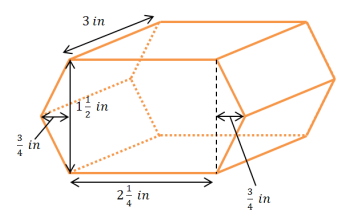
Answer:
The area of the base is the sum of the areas of the rectangle and the two triangles.
B = Arectangle+2 ∙ Atriangle
Arectangle = lw
Arectangle = 2 \(\frac{1}{4}\) in. ∙ 1 \(\frac{1}{2}\) in.
Arectangle = (\(\frac{9}{4}\) ∙ \(\frac{3}{2}\)) in2
Arectangle = \(\frac{27}{8}\) in2
Atriangle = \(\frac{1}{2}\) lw
Atriangle = \(\frac{1}{2}\) (1 \(\frac{1}{2}\) in. ∙ \(\frac{3}{4}\) in.)
Atriangle = (\(\frac{1}{2}\) ∙ \(\frac{3}{2}\) ∙ \(\frac{3}{4}\) )in2
Atriangle = \(\frac{9}{16}\) in2
B = \(\frac{27}{8}\) in2+2(\(\frac{9}{16}\) in2 )
B = \(\frac{27}{8}\) in2+\(\frac{9}{8}\) in2
B = \(\frac{36}{8}\) in2
B = \(\frac{9}{2}\) in2
V = Bh
V = (\(\frac{9}{2}\) in2 ) ∙ 3 in.
V = \(\frac{27}{2}\) in3
V = 13 \(\frac{1}{2}\) in3
The volume of the hexagonal prism is 13 \(\frac{1}{2}\) in3.